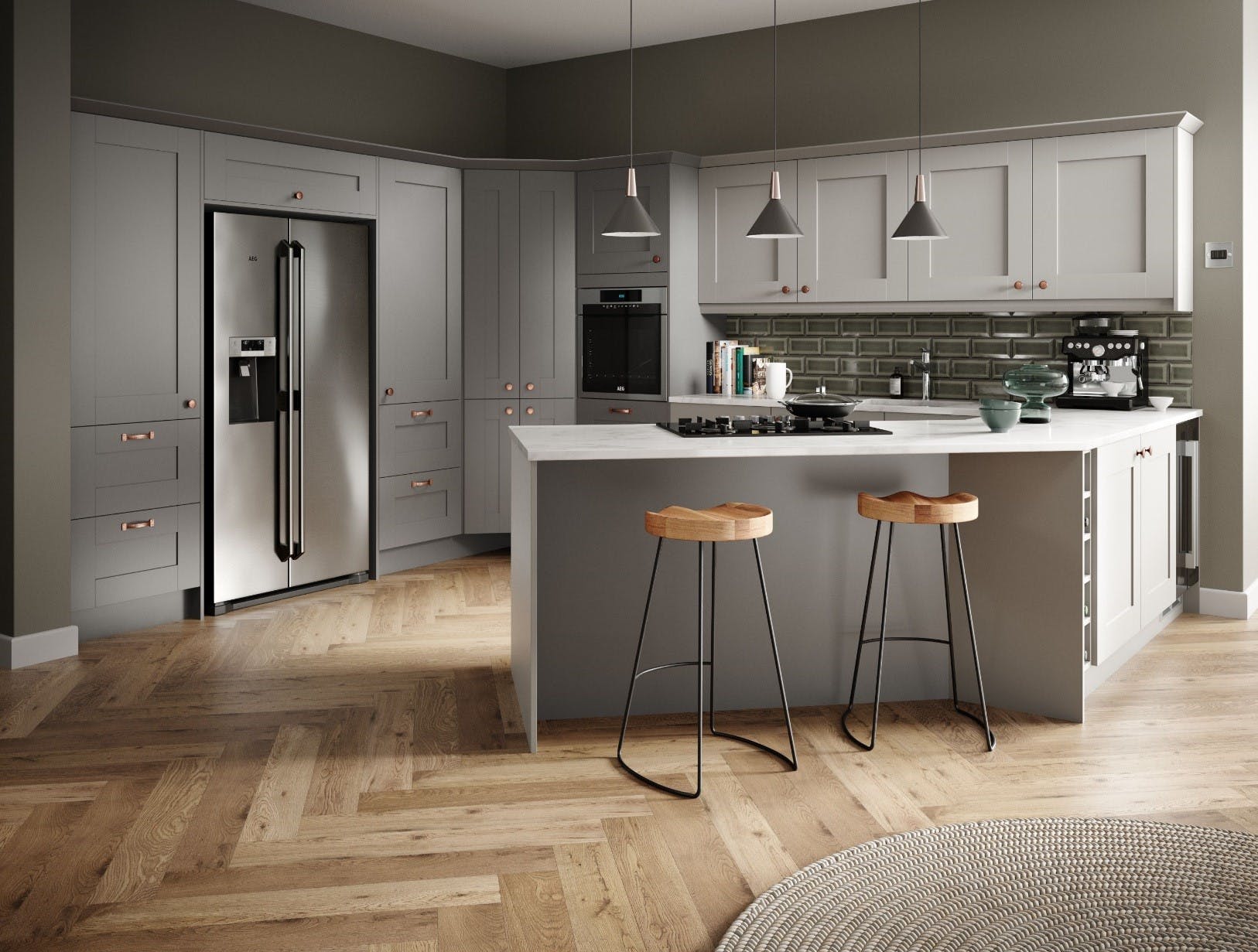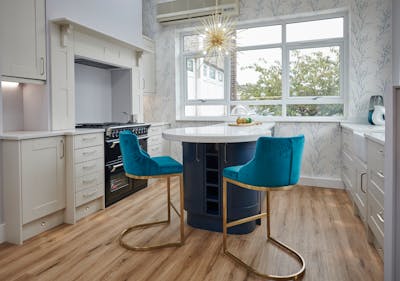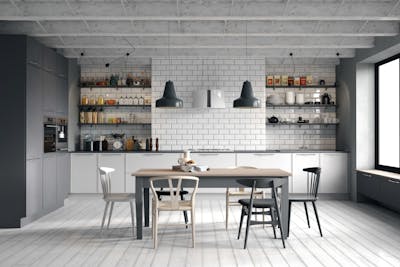Complete Guide To Kitchen Dimensions | More Kitchens
Published: 23 September 2020
If you’re thinking about renovating your kitchen and wanting to take the project on yourself then one of the most important elements when it comes to kitchen design is understanding how best to utilise your available space.
Offering a complete guide to kitchen dimensions, this article illustrates the basic standard measurements for key fixtures and appliances, so that you can plan your layout and create a kitchen design that is practical and functional.

Standard Kitchen Dimensions.
It’s possible to roughly plan out your kitchen using a 60x60cm planning model.
This planning model is the standard size for the majority of kitchen appliances such as dishwashers and ovens, and is the ‘happy medium’ of kitchen cupboard dimensions whether base, wall or tall units. Both smaller and larger options are available which we’ll cover in more detail later in this article.
What is the Average Size of a Kitchen in Square Feet?
The average size of a typical small, medium and large kitchen is detailed below:
- Small Kitchen: 70 sq. ft. (8.4ft x 8.4ft)
- Medium Kitchen: 100-200 sq. ft. (10-20ft x 10-20ft)
- Large Kitchen: 200+ sq. ft. (20+ft x 20+ft)
Based on the above, let’s presume your kitchen is classified as small, measuring 70 sq. ft. (8.4ft x 8.4ft). With a length of 8.4ft, which is 256cm, this is enough space to house four base units or appliances using the 60x60cm planning model (256cm / 60cm = 4.2).
Kitchen Cupboard Dimensions.
When it comes to kitchen cupboard dimensions, you have a number of available size options.
Despite our recommendations for using the 60 sq.cm. planning model and with limited choice when it comes to height and depth, there remain a number of width options.
Providing you know the size of your space you can really utilise it to your advantage in terms of creating additional kitchen storage. For example if you’ve got an extra 40cm to play with then why not design a section that features wider drawers rather than letting the space go to waste?For further inspiration read our dedicated article on kitchen storage ideas.

Base Unit Kitchen Cupboard Dimensions.
Base units are the foundational building blocks in any kitchen design. They offer a platform for your kitchen worktop and an area for prepping and housing your sink and cooker.
The height of a kitchen base unit is pretty standard and measures 70cm. This is in addition to the ‘cupboard legs’ which are often hidden behind a plinth which measures 15cm in height, and the worktop itself at around 5cm.
The depth of a base unit is also standard and at 60cm is in line with dimensions of standard appliances. However, you have a number of width options that range from 15cm (typically chosen for designs where a wine rack is desired) all the way up to 120cm.


Kitchen Worktop Height.
With a 70cm base unit, 15cm plinth and a worktop of 5cm, the average kitchen worktop will have a height of 90cm.
Wall Unit Kitchen Cupboard Dimensions.
The depth of wall unit kitchen cupboards is typically half that of base units in order to offer sufficient space when prepping or using the kitchen counter top - so as not to bang your head! There is also some flexibility across height, width and depth.
Standard wall unit kitchen cupboard dimensions include:


Kitchen Corner Unit Dimensions.
Whether as a base unit or a wall unit, when it comes to kitchen corner unit dimensions you firstly have two options to choose from.

Straight Kitchen Corner Unit Dimensions.
A straight kitchen corner unit is where the cupboard itself runs into a ‘blind’ corner, featuring one door and one blank section. This specific type of corner unit isn’t the most practical as it’s difficult to see inside and really utilise the space. However, additional pull out shelving and clever storage mechanisms can be installed to mitigate this.
Remembering that the height and depth are pretty rigid across both base and wall units and depending on the size of your door opening, the standard width dimensions of straight corner units are:
- 90cm
- 100cm
- 110cm
L-Shaped Kitchen Corner Unit Dimensions.
Another option would be an L-shaped kitchen corner unit which is a cabinet that features two doors set at right angles to one another.
Although there are a number of door opening options when it comes to L-Shaped kitchen corner units, the standard size measures 91x91cm wide.
Tall Unit Kitchen Cupboard Dimensions.
Another popular kitchen storage option is tall units and floor to ceiling cupboards. Great for utilising every inch of space and housing integrated appliances, with this type of storage solution no space goes to waste.
Standard options for tall unit kitchen cupboard dimensions include:


Kitchen Counter Dimensions.
Depending on your design preferences, when it comes to choosing your kitchen worktops your kitchen counter dimensions are relatively standard across all six surface options.
Whether laminate, granite, wood, corian, quartz or composite, and providing your kitchen design isn’t bespoke, your kitchen counter will typically measure as follows:
- Height (thickness): 5cm
- Depth: 65cm
arly the depth of your kitchen counter is usually ever so slightly deeper than your base units, unless opting for a linear kitchen concept. This is in order to provide a slight overhang, acting as a barrier between your legs and the base unit which accounts for any projection a kitchen handle may make.
The length of your kitchen counter is often cut to fit your work surface and is heavily dictated by your kitchen design and overall space.
Breakfast Bar Dimensions.
Ideal for small kitchens and busy families that are always on the go, incorporating a breakfast bar into your kitchen design is a great way to create a relaxed and informal seating arrangement.
Although there is no strict standard size when it comes to breakfast bar dimensions, there are some minimal height requirements that should be adhered to - but only from a practicality point of view.
What is the Minimum Height of a Breakfast Bar?
An average ‘bar’ height measures 110 cm. However, if your breakfast bar is to be an extension of your kitchen base units then we would urge you to keep these the same height, which is typically 90cm as stated above.
At the same time, if your breakfast bar is to be separate from your kitchen units then this can naturally be taller or shorter in height.
Furthermore,
no matter how big you want your breakfast bar to be in terms of how many people
it sits, you must ensure that each person would have a width or 60cm and a
depth of 35-40cm in order to sit and eat comfortably. This is derived from
standard space requirements for eating,
Finally, when it comes to choosing bar stools, make sure you
choose a stool that works well with the height of your breakfast bar but still
provides enough leg room. Strictly speaking, most standard bar stools range
from 60-80cm in height.

We hope
you’ve found our complete guide to kitchen dimensions useful and informative.
Remember to firstly measure your room and then design the layout using the
standard 60 x 60cm planning model.
Similarly, and if you’ve decided that you may have bitten off more
than you can chew and it’s time to call in the experts, here at More Kitchens
we offer a free design appointment service whereby an experienced designer will visit you at home to
learn more about your renovation requirements.
Following a detailed discussion and measuring of the existing
kitchen we will be able to offer expert advice with regards to a design and in
most cases provide you with an idea of cost.
Share this Post




























